| |
|
Market Update |
|
|
|
The USD strengthened significantly, rising 1.54% against the JPY,
buoyed by robust US labor data. The US added 232,000 jobs,
reinforcing expectations for prolonged Federal Reserve tightening.
Meanwhile, Japan's economy showed signs of contraction, with
manufacturing PMI falling to 48.5 and weaker retail sales. The Bank
of Japan’s ultra-loose monetary policy further pressured the yen.
The EUR declined 0.53% against the USD, impacted by mixed Eurozone
data, including a drop in German manufacturing PMI and persistent
inflation concerns. The European Central Bank’s cautious tone on
rate hikes added to uncertainty.
The GBP experienced mixed performance, rising 1.42% against the JPY
but falling 0.16% against the USD. UK manufacturing PMI dropped to
47.8, indicating contraction, while the services sector showed
modest growth. Weak retail sales and a cautious Bank of England
stance weighed on the pound, especially against a strong USD
supported by robust US job data.
Oil prices declined, driven by concerns over slowing demand growth,
particularly in China, and the strengthening USD. Central banks’
limited policy easing further dampened market sentiment, raising
fears of weaker economic activity in 2025. Gold prices also fell as
rising Treasury yields and a strong USD reduced its appeal. The
Federal Reserve’s projection of fewer rate cuts amid persistent
inflationary pressures further impacted gold markets.
Bitcoin faced downward pressure following hawkish Fed policy
announcements and remarks from Federal Reserve Chair Jerome Powell
rejecting the idea of holding Bitcoin reserves. Despite short-term
volatility, optimism emerged as MicroStrategy Inc. increased its
Bitcoin holdings and discussions of "buying the dip" surged.
Long-term investor confidence remains resilient despite current
market challenges.
|
|
|

|
|
Key Global Commodities
|
|
|
|
|
|
|
|
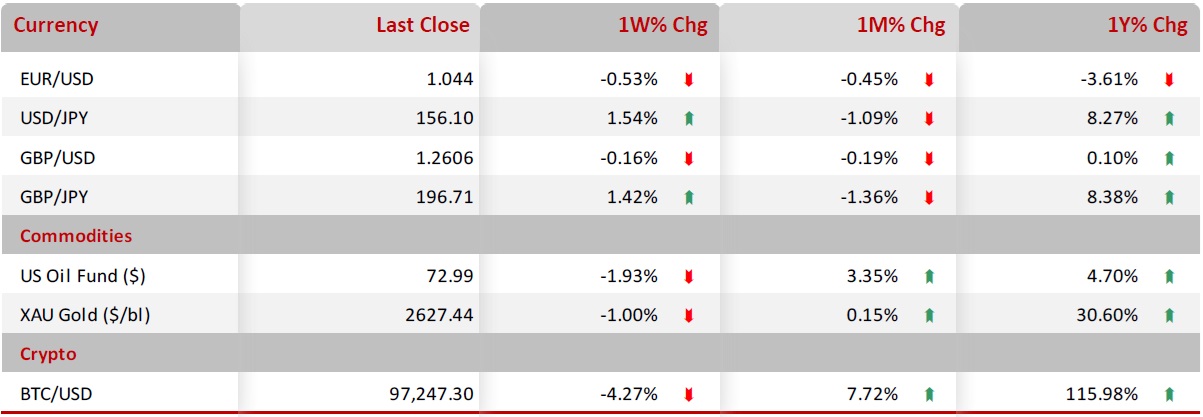
|
|
|

|
|
EUR/USD
|
|
|
EUR weakens amid US Jobs Data and ECB Outlook
|
|
|
|
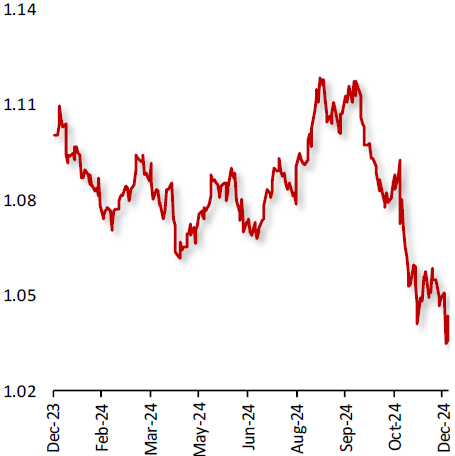
|
|
The EUR fell 0.53% against the USD during the week,
driven by mixed Eurozone data and strong US jobs
reports.
In the Eurozone, the German manufacturing PMI
unexpectedly dropped in December, signaling
continued contraction in the manufacturing sector,
though the services sector showed signs of
improvement. Germany’s Ifo business climate index
also fell, while the ZEW Economic Sentiment Index
rebounded. Eurozone inflation rose for the second
consecutive month, raising concerns about the need
for tighter policies. The ECB indicated that rates
may remain elevated for an extended period due to
persistent inflation risks, adding to market
uncertainty. German consumer confidence showed a
slight recovery in December, but broader economic
concerns remained.
In the US, the manufacturing PMI dropped in
December, but the services sector saw growth.
|
|
|
|
|
|
|
|

|
|
USD/JPY
|
|
|
Dollar strengthens amid robust US Jobs Data and Japan's
Economic Slowdown
|
|
|
|
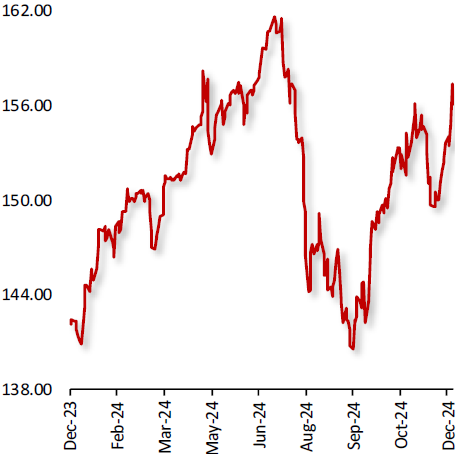
|
|
The USD rose 1.54% against the JPY during the week,
driven by stronger-than-expected US jobs data and
ongoing concerns over Japan’s economic performance.
In Japan, economic data pointed to a slowdown. The
Japanese manufacturing PMI dropped to 48.5 in
December, indicating contraction in the sector,
while the services sector showed only modest growth.
Japan's industrial production fell 0.3% in November
and retail sales were weaker than expected, raising
concerns about the pace of economic recovery. The
Bank of Japan’s continued ultra-loose monetary
policy and its commitment to maintaining low
interest rates also weighed on the yen.
Meanwhile, in the US, strong labor market reinforced
expectations that the Federal Reserve will keep
interest rates higher for a prolonged period, which
supported the USD.
|
|
|
|
|
|
|
|
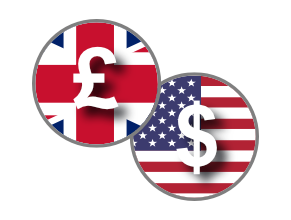
|
|
GBP/USD
|
|
|
Pound weakens amid mixed UK Data and strong US Jobs
reports
|
|
|
|
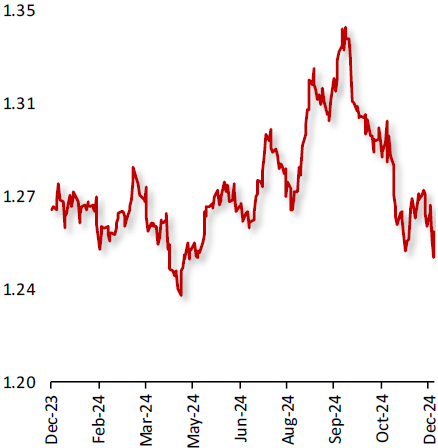
|
|
The GBP closed 0.16% lower against the USD during
the week, as a combination of mixed UK economic data
and strong US labor market reports weighed on the
currency.
In the UK, economic indicators presented a mixed
outlook. The UK manufacturing PMI unexpectedly
dropped to 48.1 in December, signaling a contraction
in the sector, while the services sector showed
resilience with a slight improvement. UK retail
sales came in weaker than expected in November,
reflecting ongoing challenges in consumer spending.
The Bank of England's recent dovish signals,
suggesting a cautious approach to further
tightening, added to pressure on the pound.
Meanwhile, in the US, the economy added 232,000 jobs
in the week ending 14 December 2024, exceeding
market expectations.
|
|
|
|
|
|
|
|

|
|
GBP/JPY
|
|
|
Pound Strengthens Against JPY Amid Mixed Economic
Signals
|
|
|
|
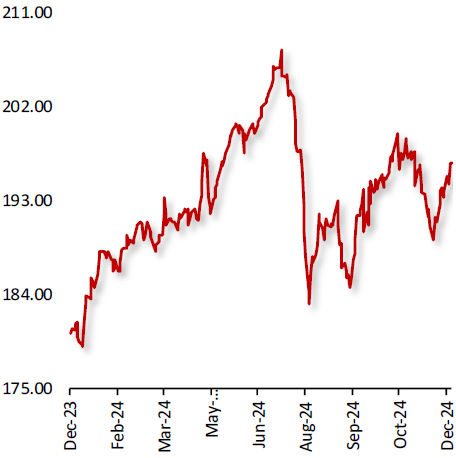
|
|
The GBP rose 1.42% against the JPY during the week,
as mixed UK economic data combined with a strong US
labor market report weighed on the pound.
In the UK, manufacturing PMI dropped to 47.8 in
December, indicating ongoing contraction in the
sector, while the services sector showed modest
growth. UK retail sales underperformed expectations
in November, highlighting persistent weakness in
consumer spending. The Bank of England’s cautious
stance on rate hikes raised concerns over slower
growth and ongoing inflation pressures in the UK.
Meanwhile, the Japanese manufacturing PMI fell to
48.5 in December, signaling continued contraction.
Japan’s industrial production dropped 0.3% in
November and retail sales were weaker than expected.
Despite these challenges, the Bank of Japan
maintained its ultra-loose monetary policy.
|
|
|
|
|
|
|
|

|
|
US Oil Fund ($/bl)
|
|
|
Oil Prices Decline Amid Demand Growth Concerns and
Strong Dollar
|
|
|
|
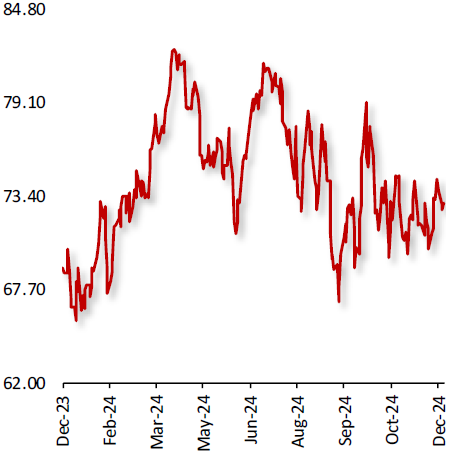
|
|
Oil prices fell last week pressured by concerns over
slowing demand growth in 2025, particularly in
China, the world's largest crude importer. The
strengthening US dollar added to the downward
pressure, as a robust dollar makes oil more
expensive for holders of other currencies,
potentially dampening demand.
Market sentiment was further weighed down by
cautious signals from central bankers in the US and
Europe. Both indicated limited room for additional
monetary policy easing, raising fears that weaker
economic activity could negatively impact oil demand
in the coming year. Although the US Federal Reserve
implemented a quarter-percentage-point rate cut as
expected, Federal Reserve Chair Jerome Powell
emphasized that persistent inflation challenges
might necessitate a more cautious approach to
further rate reductions in 2024.
Adding to the geopolitical tensions, US
President-elect Donald Trump issued a stark warning
to the European Union.
|
|
|
|
|
|
|
|

|
|
XAU Gold ($/oz)
|
|
|
Gold Prices Decline as Fed Maintains Cautious Outlook
Amid Inflation Concerns
|
|
|
|
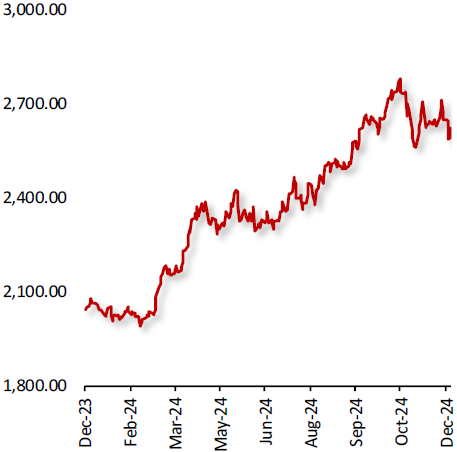
|
|
Gold prices dropped last week, as the U.S. dollar
strengthened and Treasury yields rose, driven by the
U.S. Federal Reserve’s (Fed) projection of fewer
than expected interest rate cuts for the upcoming
year amid ongoing inflationary pressures.
Adding to the negative sentiment, robust U.S. gross
domestic product (GDP) and retail sales data further
boosted the dollar, putting additional pressure on
gold prices. The Fed revised its rate cut forecast
to two from four in its prior projections, signaling
a more cautious approach as inflation remains
elevated in the U.S. through 2025.
Additionally, the Fed’s stance on maintaining
tighter monetary policy reduced gold’s appeal. As
the Fed shifts to a more gradual easing cycle,
uncertainty surrounding inflation and economic
growth continues to impact gold markets,
contributing to recent declines.
|
|
|
|
|
|
|
|

|
|
BTC/USD
|
|
|
Bitcoin Faces Market Pressures Amid Hawkish Fed Policies
|
|
|
|
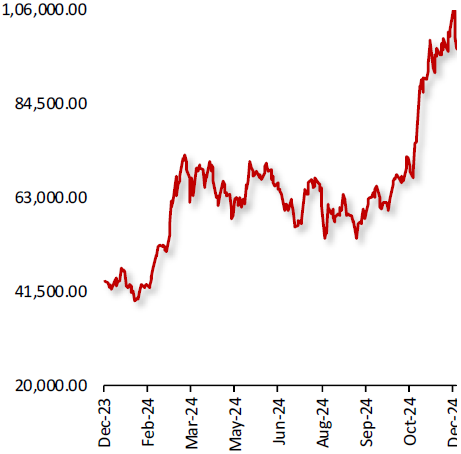
|
|
Bitcoin's price declined last week, weighed down by
hawkish US Federal Reserve policy announcements and
remarks. The US Fed’s 25-basis-point rate cut,
alongside projections for only two quarter-point
reductions in 2025, fell short of market
expectations, dampening investor sentiment. Federal
Reserve Chair Jerome Powell’s rejection of the idea
of the Fed holding Bitcoin reserves added further
pressure on the cryptocurrency market.
Amid the downturn, optimism emerged as
President-elect Donald Trump endorsed a national
Bitcoin reserve, and MicroStrategy Inc. prepared for
its inclusion in the Nasdaq 100. MicroStrategy’s
recent $1.5 billion Bitcoin purchase has bolstered
investor confidence. Additionally, social media
discussions about "buying the dip" surged to an
eight-month high, reflecting continued interest in
Bitcoin despite short-term volatility. The
combination of market challenges and long-term
optimism leaves Bitcoin at a pivotal point.
|
|
|
|
|
|
|
|

|
|
Key Global Currencies and Commodities
|
|
|
|
|
|
|
|
|
Currency
|
|
|
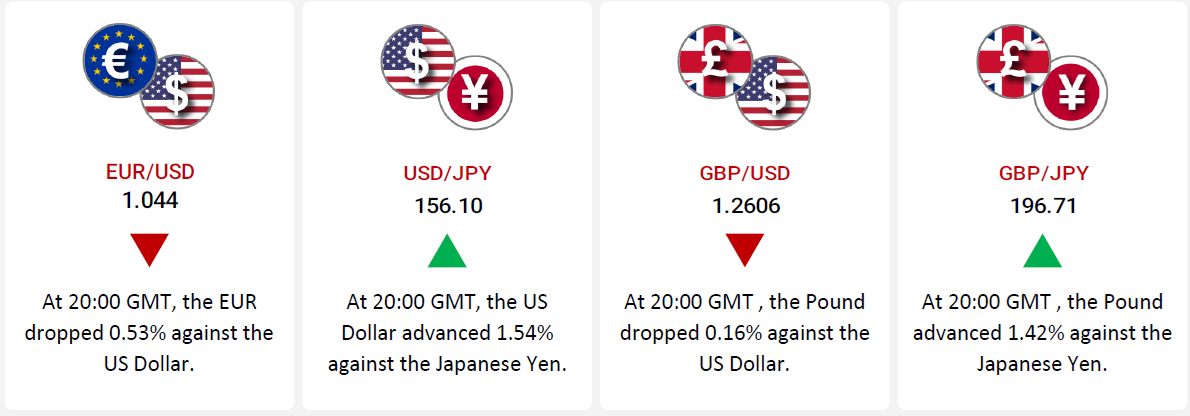
|
|
|
|
Commodities & Crypto
|
|
|
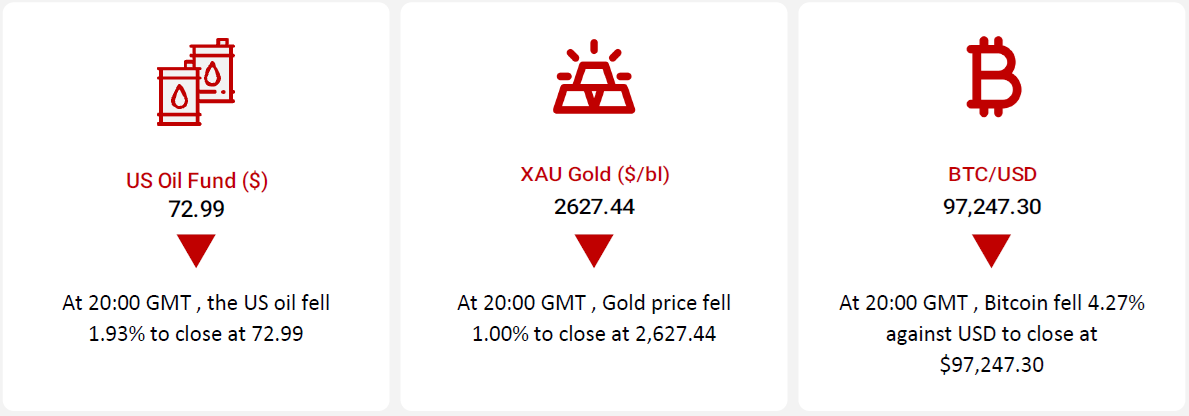
|
|
|
|
| |
|
|























